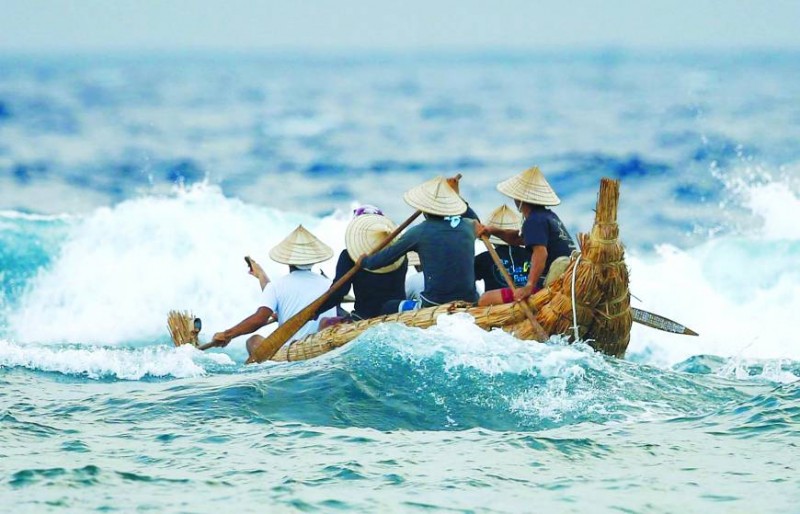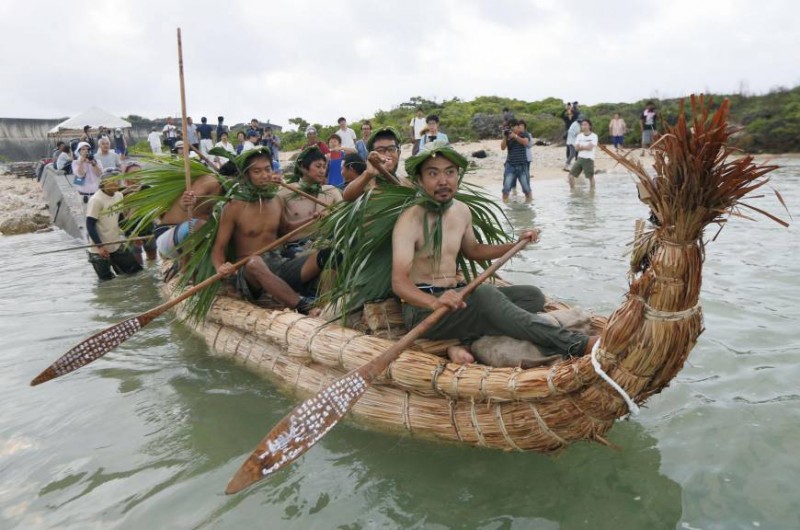An exciting experiment is being carried out in the Okinawan islands which might replicate the first coming of human beings to the Japanese islands 30.000 years ago. They came from the south, from Taiwan, presumably as part of a northward surge in the great expansion eastwards out of Africa undertaken by early mankind. What gods they brought with them we may never know, but they sure lived close to the elements and one might presume that awe and gratitude played a large part in their spirituality….

Straw boats set sail to test Taiwan-Japan settler theory
JIJI, KYODO JUL 17, 2016
YONAGUNI, OKINAWA PREF. – Two primitive straw canoes departed from Yonaguni Island on Sunday morning to reproduce a 75-km ocean voyage thought to have brought the first settlers to the Japanese archipelago about 30,000 years ago.
The voyage has “started at last,” said lead researcher Yosuke Kaifu, head of the Division of Human Evolution at the National Museum of Nature and Science. “We want to know what people 30,000 years ago did.”
The project, involving researchers from the National Museum of Nature and Science, the Okinawa Prefectural Museum & Art Museum, Nanzan University and others, is designed to test a theory that the early ancestors of the Japanese came to Okinawa from Taiwan, then part of the Eurasian continent.
The destination for the experiment is Iriomote Island. If all goes smoothly, the canoes, whose crews are navigating by the sun and the stars, are expected to complete the journey Monday afternoon. Both islands are part of Okinawa Prefecture.
Each boat contains a crew of seven, including one woman and a skipper, as part of the project. The group of 14, which includes marine adventurers, plans to row more than 30 hours to get to the remote island. Their average age is 35.
The canoes, about 6.4 meters long and 1.3 meters wide, are made of raupo, a type of bulrush that grows naturally on Yonaguni and is known locally as himegama, which is similar to narrow leaf cattail.
They are modeled after reed boats still in use on Lake Titicaca, on the border of Peru and Bolivia. Their departure was initially scheduled for Tuesday morning but was postponed due to bad weather.
Researchers hypothesize that ancient settlers traveled to Japan from Taiwan through the Nansei Islands, where many relics dating back to more than 30,000 years ago have been discovered. They believe the boats were made of grass as no woodworking tools have been found.
If the voyage to Iriomote succeeds, a similar trip from Taiwan to Yonaguni will be attempted next July. “Through the sea journey, we will be able to visualize our ancestors’ lives, which are hard to imagine merely through relic surveys,” Kaifu said.
Using a crowdfunding campaign, the national museum has raised ¥26 million for the project from about 870 people.

July 18: After 28 hours at sea, the boat arrives in Iriomote Island, proving that interisland voyages in such craft were indeed possible

Leave a Reply